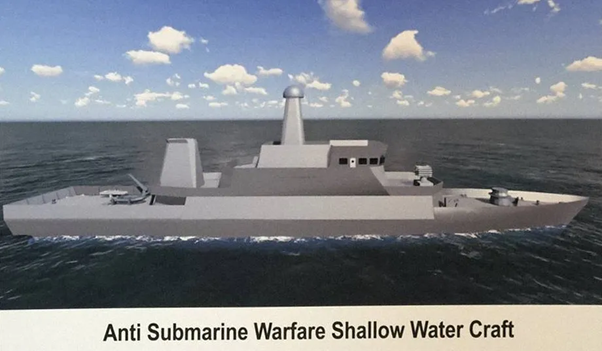Table of Contents
Anti-Submarine Warfare (ASW) Vessels
Context: Recently Two anti-submarine warfare shallow watercraft vessels of the Indian Navy’s Mahe class were launched at the Cochin Shipyard.
About Newly Inducted Vessels
- INS MALPE and INS MULKI are 4th and 5th in a series of Eight ASW Vessels deal signed between the Ministry of Defence and Cochin Shipyard Ltd.(CSL) in 2019.
- Mahe, Malvan, and Mangrol, were earlier Mahe-class vessels built by CSL.
- The Mahe-class of ships will replace the in-service Abhay-class ASW corvettes
- Features:
- Designed to accommodate indigenously developed sonar for underwater surveillance.
- Equipped with light-weight torpedoes, anti-submarine warfare (ASW) rockets and mines.
- Installed propulsion power: 12 MW
What are Anti-Submarine Warfare Vessels?
- ASW vessels are designed to detect, track, and destroy enemy submarines.
- They are equipped with a variety of weaponry and tactics and can be used for low-intensity maritime operations and mine-laying.
- Role of ASW Vessels:
- Search and Rescue
- Anti-submarine operations in coastal waters
- Low intensity maritime operations and mine-laying operations

Elongated Tortoise
Context: Recently an Elongated tortoise (Indotestudo elongata) was spotted in Haryana’s Damdama area during a research survey in the Aravallis.
About Elongated Tortoise
- It is also known as Sal Forest Tortoise
- IUCN Status: Critically Endangered
- Cites: Appendix II
- Habitat:
- Open deciduous forest patches, including Sal Forest
- Evergreen forest habitats
- Dry thorn forests & Savannah grasslands.
- Distribution:
- Nepal, Bhutan, Bangladesh, Myanmar, Thailand, China, Malaysia, Cambodia etc.
- India: Himalayan foothills and Northeast India
- Threats:
- Forest Fires
- Hunting & Illegal Collection for Pet Trade
- Habitat loss & Over-exploitation

| Fact |
|
Helium & its Space Applications
Context: Recently Many space missions have encountered problems due to faulty propulsion systems & other problems related to Helium leaks. This includes Boeing’s Starliner & SpaceX’s Polaris Dawn mission.
About Helium
- It is a colourless, odourless, and tasteless gas
- It has a very low density, as compared to oxygen and nitrogen.
- It is chemically inert and doesn’t react with most other substances.
- It has a low boiling point (-268.9 °C), allowing it to remain a gas even in super-cold environments.
- It is nonflammable and doesn’t react with oxygen.
Applications/Uses of Helium
- Space Sector
- It is used to pressurise fuel tanks, ensuring fuel flows to the rocket’s engines without interruption.
- It is used to detect leaks in critical equipment such as rocket engines
- It is used to cool scientific payloads & to refrigerate fuel-handling systems.
- Other Applications:
- Medical: It is used in MRI machines and to treat respiratory conditions like asthma and emphysema
- Manufacturing: It is used in the production of semiconductors and fiber optics. It’s also used in arc welding as an inert protective gas.
- Barcodes: Helium-neon gas lasers are used in barcode scanners at supermarkets.


 Places in News for UPSC 2025 for Prelims...
Places in News for UPSC 2025 for Prelims...
 New Phase of Operation Chakra to Combat ...
New Phase of Operation Chakra to Combat ...
 Soyuz Aircraft: History, Design and Sign...
Soyuz Aircraft: History, Design and Sign...





















